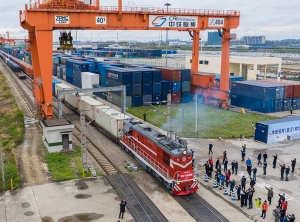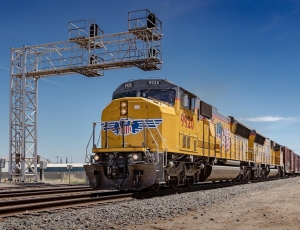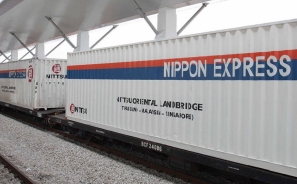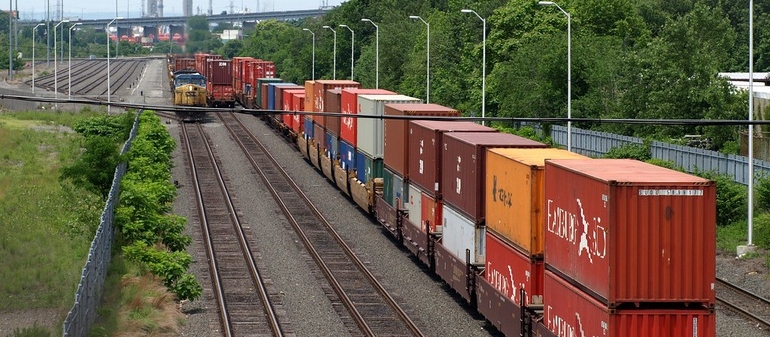China-Europe Freight Train Service Resumed in Wuhan
 April 8, 2020 - China-Europe freight train service from Wuhan, the capital city of Hubei province, resumed regular operations on Saturday, March 28, allowing more goods such as medical supplies and daily necessities to flow more efficiently between the two regions, according to the Wuhan branch of the China State Railway Group. April 8, 2020 - China-Europe freight train service from Wuhan, the capital city of Hubei province, resumed regular operations on Saturday, March 28, allowing more goods such as medical supplies and daily necessities to flow more efficiently between the two regions, according to the Wuhan branch of the China State Railway Group.
On Saturday morning, the X8015/6 rail carrying 50 cargo containers left the Wuhan station en route to central Europe. It is the first freight train of its kind to leave Wuhan after the COVID-19 outbreak began, and it is estimated to reach Duisburg, Germany in 15 days.
Nearly 90 percent of all goods aboard were produced locally in Wuhan, including 166.4 metric tons of medical supplies such as medical fabrics. There were also auto parts, electronics and telecommunication cables on the train, and all these goods would aid in pandemic control and construction projects in European countries such as Germany, France, Hungry, the Czech Republic and Poland.
The company said the normalization of railroad operations marked the city’s logistics and production are gradually recovering from the epidemic, and will serve as a strong support for commerce and trade.
The train’s schedule and operations have been optimized to be more efficient, with some fees on international goods and relevant paperwork waived to save time during this global health crisis. More freight trains ferrying goods between the two regions will likely be in place in the future.
From March 23 to 26, the China-Europe freight train service connecting Hefei, Anhui province, and Europe had resumed operation. It traveled to Germany, Russia, Kazakhstan and Uzbekistan, carrying goods including cars, refrigerators, washing machines, auto parts, electronics and many medical supplies.
SOURCE: China Daily |
AAR Reports Total Carloads and Intermodal Units Down 7.6 Percent in Week 11
 March 23, 2020 – The Association of American Railroads (AAR) on March 18 reported U.S. rail traffic for the week ending March 14, 2020 (Week 11). March 23, 2020 – The Association of American Railroads (AAR) on March 18 reported U.S. rail traffic for the week ending March 14, 2020 (Week 11).
For this week, total U.S. weekly rail traffic was 463,017 carloads and intermodal units, down 7.6 percent compared with the same week last year.
Total carloads for the week ending March 14 were 226,039 carloads, down 5.9 percent compared with the same week in 2019, while U.S. weekly intermodal volume was 236,978 containers and trailers, down 9.1 percent compared to 2019.
“Intermodal, rather than other rail sectors, is likely to see the earliest impacts from the coronavirus because large amounts of intermodal traffic go to or come from ports – roughly half of U.S. intermodal is exports or imports,” said AAR Senior Vice President John T. Gray.
“Unfortunately, extensive flooding and harsh winter weather last year at this time complicate comparisons between this year and last year. That said, the fact that overall intermodal originations last week were the lowest for the same week since 2013 is strong evidence that the coronavirus is impacting intermodal volumes. This is emphasized by the fact four of the five carriers of intermodal traffic from west coast ports, the principal gateways serving the Chinese trade, saw declines in their intermodal business handled. Similar declines in the East also suggest that the problem has begun to spread to other regions of the supply chain”
Six of the 10 carload commodity groups posted an increase compared with the same week in 2019. They included grain, up 1,288 carloads, to 19,911; motor vehicles and parts, up 1,180 carloads, to 19,104; and petroleum and petroleum products, up 1,164 carloads, to 13,294. Commodity groups that posted decreases compared with the same week in 2019 included coal, down 16,545 carloads, to 55,542; nonmetallic minerals, down 2,468 carloads, to 30,254; and metallic ores and metals, down 992 carloads, to 19,975.
Forest Products
Total carloads of North American rail traffic for forest products in Week 11 were 16,441, down 3.7% compared to the same week in 2019. The forest products category include: primary forest products, lumber & wood products, and pulp & paper products.
For the first 11 weeks of 2020, U.S. railroads reported cumulative volume of 2,549,159 carloads, down 6.2 percent from the same point last year; and 2,712,444 intermodal units, down 7.8 percent from last year. Total combined U.S. traffic for the first 11 weeks of 2020 was 5,261,603 carloads and intermodal units, a decrease of 7 percent compared to last year.
North American rail volume for the week ending March 14, 2020, on 12 reporting U.S., Canadian and Mexican railroads totaled 332,044 carloads, down 3 percent compared with the same week last year, and 312,938 intermodal units, down 9.8 percent compared with last year. Total combined weekly rail traffic in North America was 644,982 carloads and intermodal units, down 6.4 percent. North American rail volume for the first 11 weeks of 2020 was 7,223,977 carloads and intermodal units, down 5.3 percent compared with 2019.
Canadian railroads reported 84,612 carloads for the week, up 6.3 percent, and 60,886 intermodal units, down 12.8 percent compared with the same week in 2019. For the first 11 weeks of 2020, Canadian railroads reported cumulative rail traffic volume of 1,553,013 carloads, containers and trailers, down 1.6 percent.
Mexican railroads reported 21,393 carloads for the week, down 5.0 percent compared with the same week last year, and 15,074 intermodal units, down 8.9 percent. Cumulative volume on Mexican railroads for the first 11 weeks of 2020 was 409,361 carloads and intermodal containers and trailers, up 4.2 percent from the same point last year.
SOURCE: Association of American Railroads (AAR) |
Nippon Express Launches Intermodal Transport Service from Europe to Japan via Taicang, China
 Feb. 28, 2020 - Nippon Express Co., Ltd. has launched "NEX Ocean-Solution China Land Bridge EJ (Europe-Japan)" intermodal ("rail & sea") service from Europe to Japan via Taicang, China, that uses cross-border rail transport between Europe and China. Feb. 28, 2020 - Nippon Express Co., Ltd. has launched "NEX Ocean-Solution China Land Bridge EJ (Europe-Japan)" intermodal ("rail & sea") service from Europe to Japan via Taicang, China, that uses cross-border rail transport between Europe and China.
The intermodal service, launched on February 19, combines rail transport from Europe (Hamburg and Duisburg in Germany as well as Malaszewicze in Poland) to China (Xian) with marine transport from the Port of Taicang to major ports in Japan (Tokyo, Yokohama, Nagoya, Osaka and Kobe). The lead time from various railway terminals in Europe to these major Japanese ports is 26-28 days.
Service features
- Lead time is substantially shorter than that for "all-water" marine transport (approximately 40 days).
- Lead time is shorter by about one week, and transport costs about 40% lower, than for conventional rail & sea intermodal transport service from Europe via Dalian, China.
- Scheduled trains depart European rail stations bound for Xian Station twice weekly (on Wednesdays and Fridays), making it possible to link up flexibly with marine transport.
- Background to service development
In November 2015, Nippon Express began offering cross-border rail transport service between China and Europe as a "third transport mode" between air and marine transport and established this as a viable transport means.
Intermodal transport service from Japan to Europe via Dalian, China, using China-Europe railways was launched in May 2018, and then complemented in September 2019 by sea & rail intermodal transport service via Xiamen (Amoy), China. The significant interest shown by customers in this "third transport mode" has prompted Nippon Express to consider developing services for other routes, and the latest addition to its service lineup offers customers shorter lead times, lower costs and greater convenience.
SOURCE: Nippon Express Co., Ltd. |
AI is reshaping transportation. Railroads can get on board or miss out
Will policy challenges derail freight rail's progress toward a sustainable future?

The following is an opinion piece written by Ian Jefferies, president and CEO of the Association of American Railroads and published in Supply Chain Drives. Opinions are the author's own.
Feb. 7, 2020 - The White House recently issued draft principles for governing the use of artificial intelligence across sectors, including transportation. While a recent report noted the guidance may be too vague to produce substantive benefits, the larger point is clear. Various forms of AI are here to stay and will only become more ubiquitous.
That is unless public policymakers go to great lengths to inhibit progress. The industry I represent, one of America's oldest industries – privately owned freight railroads – stands in the crosshairs of this very discussion.
At issue rests a fundamental question that Silicon Valley innovators likely never contemplate: can established industries, such as freight rail, reimagine themselves through technology in an era of massive disruption?
As upstarts like Hyperloop One or the truck platooning company Peloton seek market entry, can freight rail deploy AI-like technologies that boost safety performance and productivity, and in turn maintain or grow market share? Or, will narrow debates – such as an ongoing regulatory dispute over the number of people needed in a locomotive cab – derail progress toward a sustainable future?
For freight railroads, which invest billions to maintain and modernize private networks, these questions are being answered in real time.
"The U.S. rail industry and the multi-billion dollar infrastructure it supports is well positioned to capture the benefits of new technologies that will automate systems to improve safety and provide better value to consumers," according to a report from the R Street Institute and TechFreedom.
Many technological solutions are already online, because a safe network is in the best interest of carriers and their customers. In fact, a single train has a wide network of people and technology monitoring its status and performance that goes beyond having one or two people in the locomotive cab.
"Continued evolution for large U.S. freight railroads, however, will be near impossible with two hands tied behind their back. The market won't wait."
While a car or a truck may use cameras, speed controls and advanced warning systems, railroads already deploy an all-of-the-above arsenal that provides dozens, if not hundreds, of checks on a single unit. It is akin to the "smart infrastructure" mentioned when discussing autonomous vehicles.
For instance, railroads are in the final stretch of implementing Positive Train Control, or PTC, on much of the mainline network. This anti-crash technology, made possible through a private wireless network and GPS mapping, will help prevent incidents caused by human error, including train-to-train collisions and derailments caused by excessive speed.
In addition, railroads use a time-tested tool known as a "locomotive alerter" that requires the train operator to confirm every minute he or she is driving the train. Failure to do so causes a train to shut down, thus ensuring even trains operated with only one person have attentive operators and are safe.
At the same time, track geometry cars can constantly monitor track integrity, and rely on a network of sensors to inspect infrastructure and equipment in real time. Coupled with big data analysis, these tools supplement traditionally manual functions and are proving better than human operators at identifying issues before they arise.
These digital tools provide an additional layer of oversight as railroads deploy ground personnel throughout the network to monitor trains and communication systems remotely.
While automated technologies have and will continue to change the rail workforce ... innovation in the sector and across the economy will be a net positive for the economy."
Common ground between management and labor should reflect these realities without barring the industry from deploying assets and people in the most sensible way in the future. After all, the Federal Railroad Administration – the regulator responsible for ensuring rail safety – recently ruled there is no need for regulation mandating minimum crew sizes.
In the more highly-regulated European environment, most freight trains operate with one person, while in Australia there is a long-distance freight train that is fully autonomous.
Many smaller railroad companies in the U.S., and almost all passenger carriers, deploy only one person in the locomotive cab. Indiana Railroad, for instance, runs over one-third of its operations with one person in the locomotive and maintains a sterling safety record after more than 20 years of doing so.
"Continued evolution for large U.S. freight railroads, however, will be near impossible with two hands tied behind their back. The market won't wait."
An inability to ultimately deploy one-person crews would "exclude freight rail from the increased productivity of the digital age, even with the widespread anticipation of self-driving cars and semis," Elliott Long, a policy analyst at the Progressive Policy Institute said in a Medium post.
In short, the freight rail industry should be able to gradually transition from two people in the locomotive of the cab to one onboard crewmember with the support of in-cab technology and on-the-ground conductors.
While automated technologies have and will continue to change the rail workforce – as they have for decades alongside safety gains – innovation in the sector and across the economy will be a net positive for the economy.
Railroads take trucks off roads, reducing infrastructure damage and carbon emissions in the process and. U.S. freight railroads can, on average, move one ton of freight more than 470 miles per gallon of fuel, making rail the most environmentally friendly way to move freight over land.
Railroads are reimagining the way they move freight, hoping to reach new safety levels, meet burgeoning demand and increase customer service. Technology is at the core of this effort. The public should support more innovation, not less.
SOURCE: Supply Chain Drive |
|
|